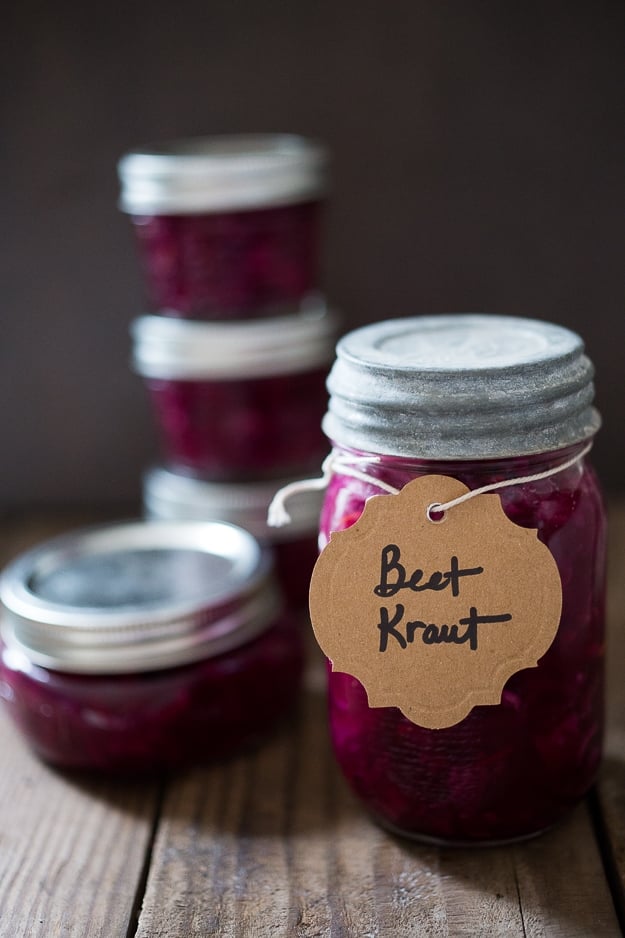
In this recipe, I use purple cabbage and grated beets, which give it this beautiful vibrant color. But feel free to use just cabbage if you prefer. The refreshing bite is such a welcome accompaniment to dinner, especially with heavier meals, providing good contrast in texture and flavor. It’s also delicious on sandwiches, in tacos, wraps or have a bowl of it on its own. And you really don’t need any special equipment to make this…. a mason jar works just as well as a crock.
For the love of Beets!
Not only are beets earthy, sweet and full of flavor, but beets are also a nutritional powerhouse! They are full of incredible antioxidants, beets can lower blood pressure and reduce inflammation. If you looking for new ways to incorporate beets in the kitchen, take a look at our 20 Best Beet Recipes– you’ll find some delicious inspiration here!
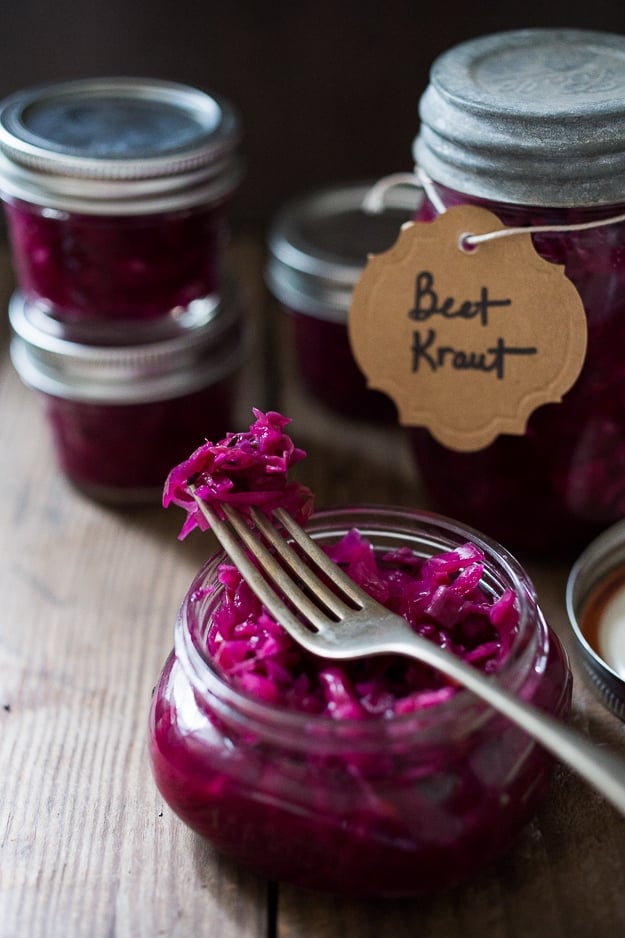
Benefits of Fermented Sauerkraut
The main reason I am in love with homemade kraut is it’s incredibly good for our bodies. The simple fermentation process creates healthy bacteria, that have amazing cancer-fighting and immunity-building properties, similar to the healthy probiotics in yogurt, but without dairy and fat. As cabbage ferments, it produces living bacteria that give our microbiome diversity!
These good bacteria, or “probiotics” help boost our whole immune system, keeping us healthy and better able to ward off illnesses.
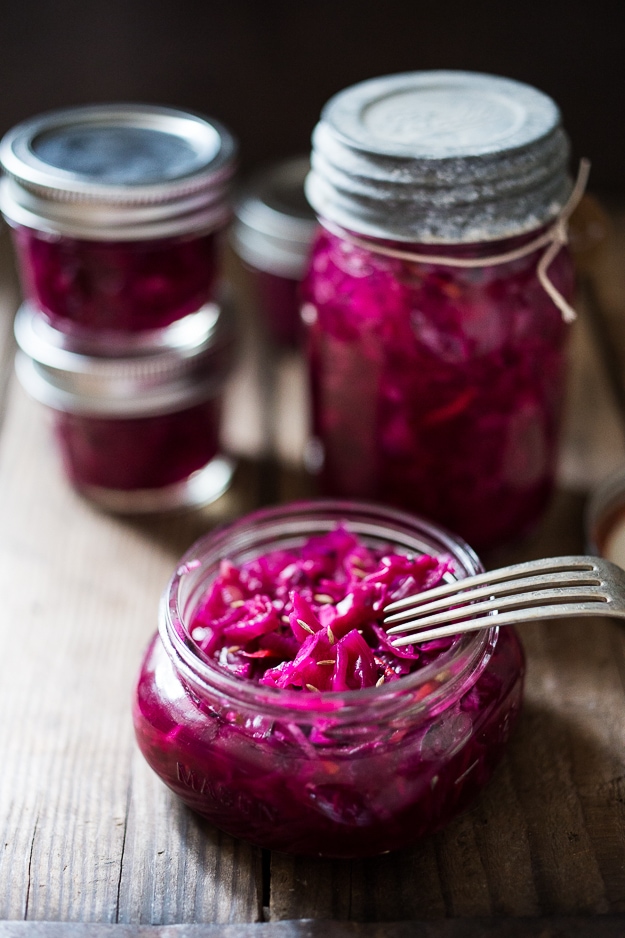
But if you eat sauerkraut that has been pasteurized (the store-bought kind, canned and not refrigerated) the heat in the pasteurization process actually kills these good live bacteria, and so we won’t benefit from the probiotics…and that’s why I like to make it at home.
Plus it’s SO easy, and you can flavor it however you like.
Beet & Cabbage Kraut Ingredients
- organic purple cabbage ( or green cabbage)
- organic red beet ( or golden beets)
- onion, garlic or ginger- all optional
- mineral salt or sea salt, do not use iodized salt or kosher salt
- optional: caraway seeds, herbs.
How to make Beet Sauerkraut
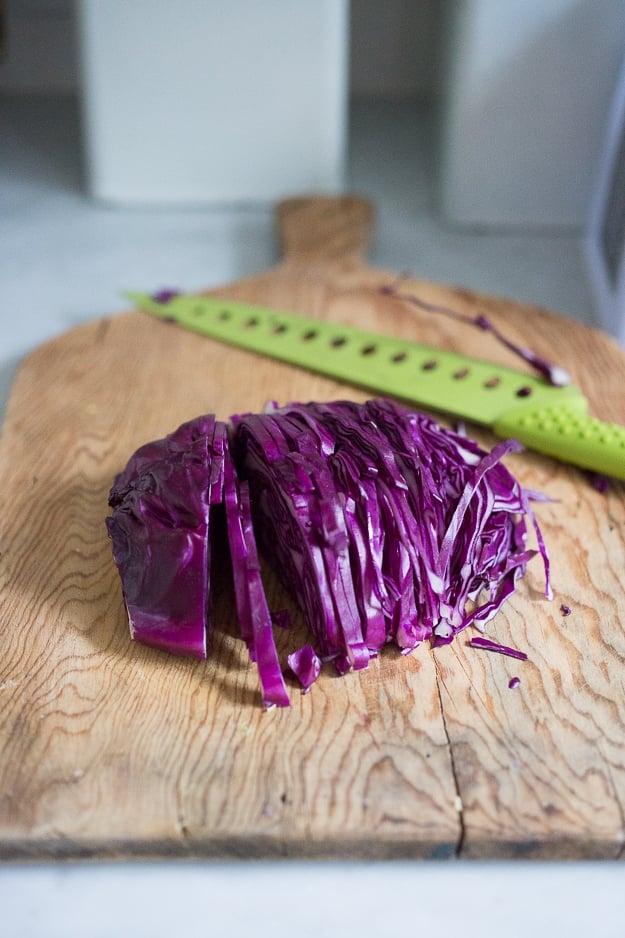
Step one: Finely slice and grate cabbage and raw beets.
I like to add a ⅛ to ¼ cup of sliced onion, and sometimes minced garlic. This is optional. It will make the smell slightly off-putting as it ferments, but once it’s refrigerated, it adds a really delicious flavor.
Step two: Weight the cabbage-beet mixture in grams. Multiply this by .02. This is the amount of salt you will need in grams. ( See recipe notes) Measure out the salt.
Step three: Massage the cabbage-beet mixture with the salt. Let it sit in the bowl on the counter, occasionally mixing for a 1-2 hours. Add caraway seeds if you like, or a little grated ginger.
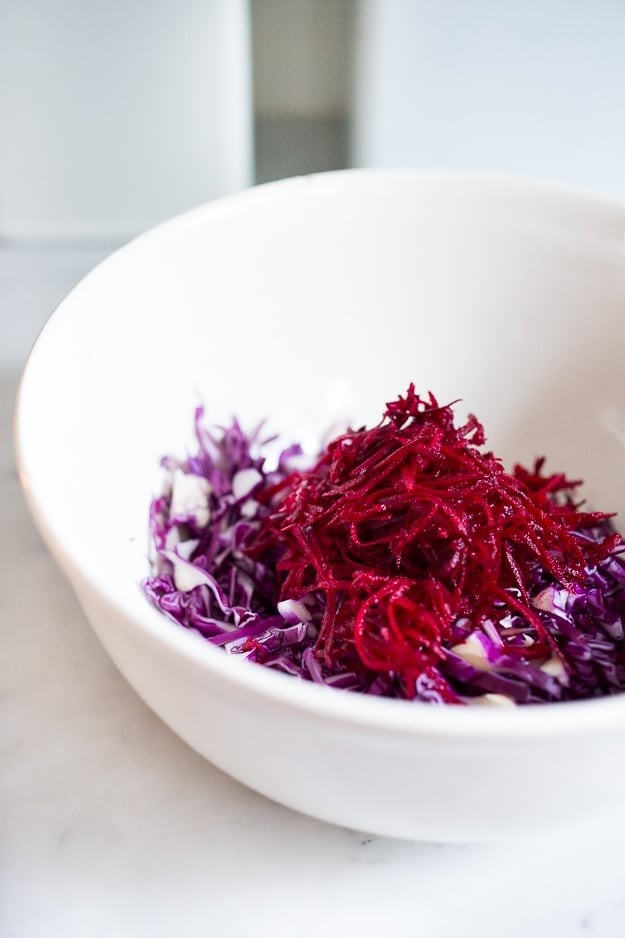
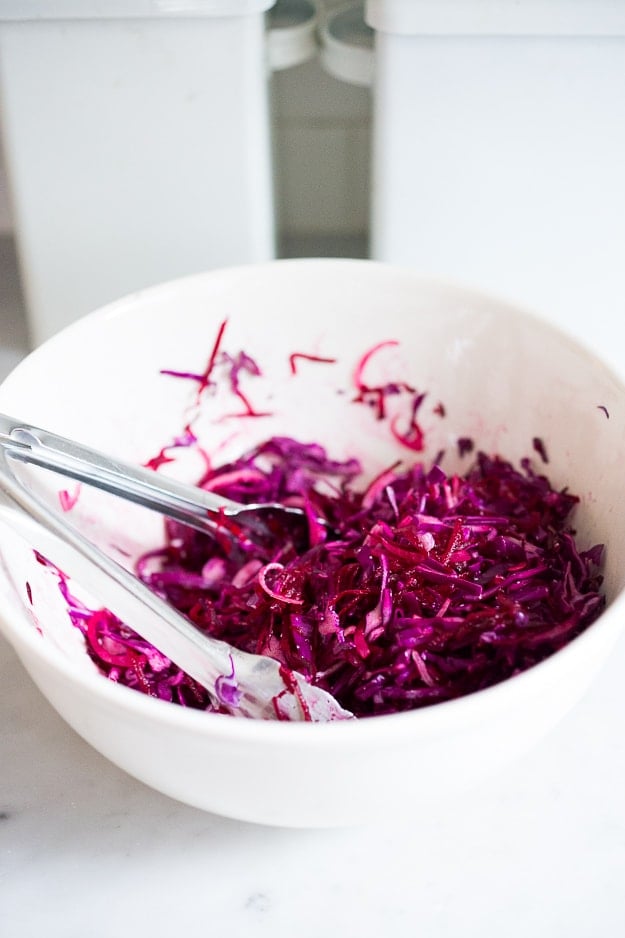
Step 4: Place the cabbage mixture along with all the juices in clean mason jars, and pack it down with a muddler or the end of a wooden spoon. Cover it with a cabbage leaf. Pack it down once more so cabbage is under the brine.
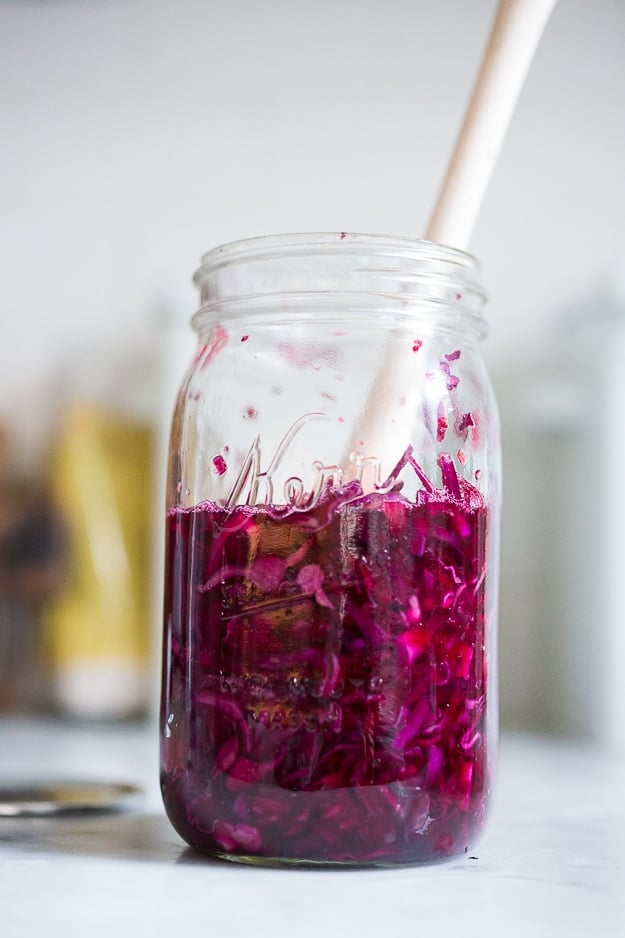
Step 5: Then leave it on the counter, with the cabbage weighed down ( see notes) and covered loosely with a lid, over a plate or pan to catch any juices, with a dishcloth placed over it (or place somewhere dark and cool, ideally 65- 72 degrees F) for 3-5 days, or longer if you prefer more fermentation, occasionally pressing down on the cabbage.
My personal preference is 4-5 days at 65F for a refreshing and crunchy version. After a few days, you should start to see some activity, bubbles, with you tap the jar.
Step 6: Refrigerate. After 3-7 days, close it with a lid and put it in the fridge…and don’t worry, it will smell better once it is chilled. Once it chilled, it’s ready to eat. As it rests in the fridge, it will continue to ferment but at a much slower rate. It will taste better and better.
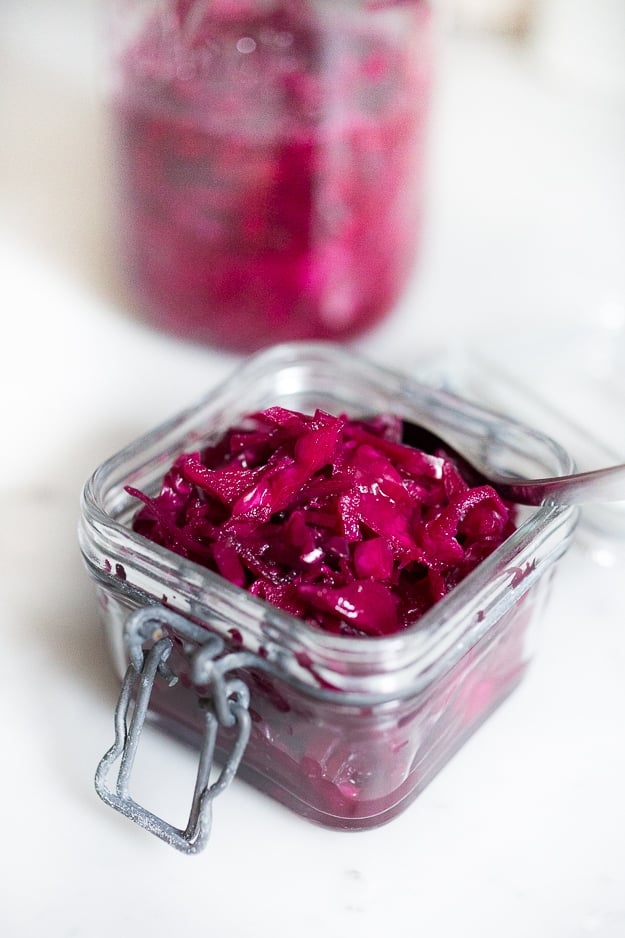
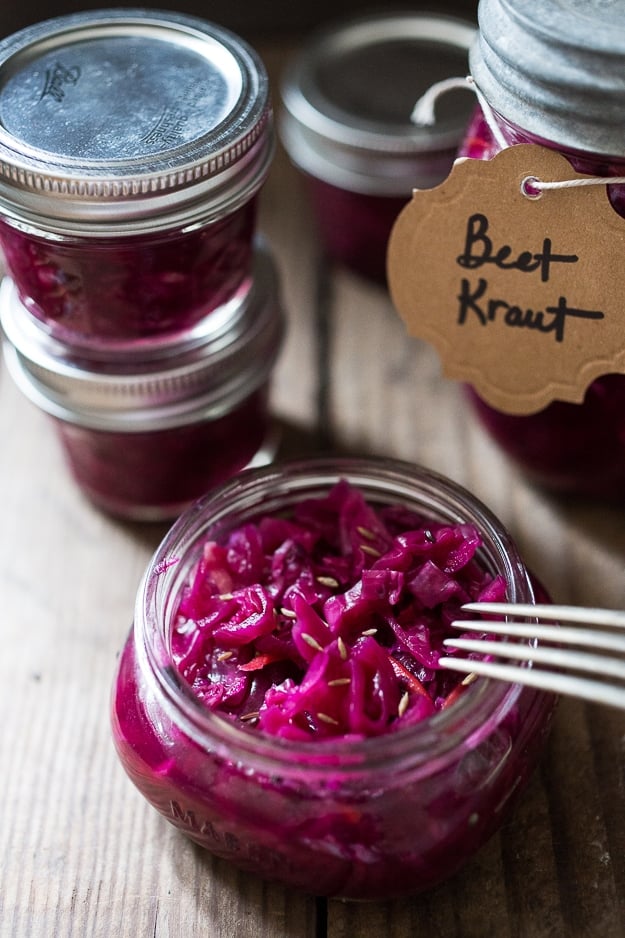
More recipes you may like:
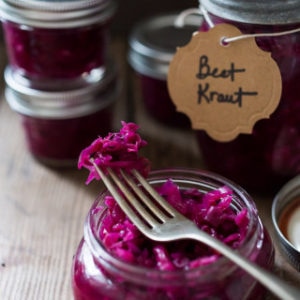
Beet and Cabbage Sauerkraut
- Prep Time: 20 mins
- Total Time: 20 mins
- Yield: 4 cups
- Category: sauerkraut
- Method: fermented
- Cuisine: Preserving
- Diet: Vegan
Description
A simple easy, small-batch recipe for Beet and Cabbage Sauerkraut that anyone can make using a mason jars. Full of good healthy bacteria! Allow 5 days fermenting time!
Ingredients
- 1 small red cabbage- finely sliced (save a couple whole leaves , for the top)
- 1 cup grated raw beet- do not peel.
- 1/8-1/4 cup sliced red onion - optional
- mineral salt or sea salt (you will calculate)
- 1 teaspoon caraway seeds
- 1 garlic clove, sliced
- 1-2 teaspoons grated ginger
Instructions
- Place a medium bowl on a scale and zero out the scale, leaving the bowl there.
- Finely slice and grate cabbage and beets and place in the bowl. Add garlic, onion and or ginger if using.
- Weigh the cabbage in grams- careful not to include the bowl weight. Multiply the cabbage amount by .02. This is the amount of salt in grams you will need ( see notes). Zero out the scale again, with the filled bowl, and add the calculated salt.
- Massage the with the salt, Let sit on the counter, mixing occasionally for 1 hour, until cabbage has wilted and released a little water.
- Place cabbage beet mixture and all the juices in a CLEAN mason jars and pack it down with a muddler, or the end of a wooden spoon, leaving 2-3 inches at the top. Place a couple of cabbage leaves over the kraut to help keep it submerged under the liquid along with a fermentation weight.
- If there is not enough liquid to cover, mix one teaspoon sea salt with 1 cup of filtered water, and add just enough of this brine so cabbage-beet mixture is submerged- leaving at least 2-inches space at the top of jar. If any seeds or particles float to the top, remove them with a slotted spoon. Anything that is not completely submerged can mold. Cover loosely with a lid and place on a pan ( to catch any liquid).
- Place in a cool dark place ( ideally 65 -72 degrees F ) for 3-5 days. It may take longer to ferment if it is colder. I often place mine in the cooler part of my kitchen, covered with a big dishcloth. You can check it daily to make sure the cabbage is under the brine.
- After 3-4 days, check for activity. When you tap the jar, tiny bubbles should rise to the top, indicating it’s fermenting. Once fermented to the desired amount, add the caraway seeds and place it in the fridge. The longer it ferments the sourer it will taste.
- Once it’s chilled the smell will surprisingly mellow out and it will actually seem edible! So let it chill overnight, discard the cabbage leaf, then give it a taste!
Notes
Salt Ratio: The recommended salinity for Sauerkraut is 1.5% – to 2.5% salt to the weight of the cabbage. Here we use 2% salt to the weight of the cabbage. Example: 1ooo grams cabbage multiplied x .02= 2o grams of salt. Feel free to use more or less as long as it stays between 1.5% and 2.5%. I use Himalayan Sea Salt and Real Salt. Both are natural and unrefined with high mineral content.
Cabbage: Use organic cabbage if possible. Do not use pre-shredded cabbage. You need the natural bacteria from a whole cabbage. Farmers’ market cabbage works especially well.
Use a fermentation weight to keep the kraut submerged or something small and clean that will fit inside the jar, like a small shotglass.
Nutrition
- Serving Size: 1/4 cup
- Calories: 45
- Sugar: 3.4 g
- Sodium: 670.6 mg
- Fat: 0.2 g
- Saturated Fat: 0 g
- Carbohydrates: 10.2 g
- Fiber: 2.1 g
- Protein: 2 g
- Cholesterol: 0 mg






Yum. Whats the proper temp to ferment? It did nothing when cool but started to fetment when in a warmer space
Ideal temp is 65-72 F. It takes little longer when cooler. 🙂
Mine has some browning on the top. Is this ok?
I’m on day 3 and having some browning on the top. Is this normal?
Are you using anything to weigh dow the slaw?
Just the cabbage leaf. Has it gone bad?
No, not at all! Basically it’s browning because it’s sitting on top of the liquid. The cabbage leaf helps keep the kraut submerged in the liquid. You could also weight the kraut down with a ziplock bag of beans or zip lock bag of water. Even if the top of the kraut were browning, it’s probably fine underneath, just scoop it off. 😉
Thank you so much!
My friend and I made this on a lark and it was such a success and very easy. Highly recommend adding it to your cooking repertoire.
When do you add the optional ingredients??
Sorry Tra! I fixed the recipe….you add it with the other ingredients.
Is the apple cider considered an optional ingredient? Or, when is t added? Thanks!
Do you think this would work with steamed beets? I bought a big pack and am not sure what to do with them!
I have never tried it with steamed beets, but my feeling is they need to be raw. Im sorry, I wish I knew more!!!
My impression is that it will work just fine, as long as the cabbage is raw. There should be enough good bacteria on the cabbage to get the ferment going. Cooked beets might seem a bit slimy after they ferment, but that shouldn’t cause a problem with the taste.
Thanks Jim! Good to know!
Awesome trouble free recipe. The ginger addition makes it quite favorful.
Awesome trouble free recipe. The ginger addition makes it quite favorful.
i think it’s a great recipe – I can’t wait until my batch is ready!
So I made this and has been in the fridge about 2 months. When I put it in it was covered in liquid. Just took it out and no more liquid. Doesn’t smell horrible, should I toss it? Any thoughts?
That’s strange! Was there a lid on this? Is there any liquid in the jar at all?
I know this is a little late, but I’ve heard that the cabbage can reabsorb the moisture with the temperature change.
I know this is a little late, but I’ve heard that cabbage to reabsorbs and releases liquid depending on the temperature. That’s probably what happened.
Hi there,
I prepared this beet/cabbage sautkraut recipe 2.5 days ago with one modification. I put a jar of water on top of the cabbage leaf to weigh it down a bit. I lifted the jar this morning and there was a beet coloured syrup that oozed off the bottom of the jar. It had a mother-like consistency but it seems like it would be far too fast for something like that. Do you think it could be from the beet sugar? Have you ever seen something like this before?! Other than that I think it looks ok, but I’d love to hear your feedback on what you think it is and if my kraut is still ok 🙂
It sounds like it is fermenting quite fast, it must be pretty warm in your kitchen? I would place in a cooler spot for a couple days if possible, then in the fridge. Or you could place in the fridge now.
And yes, I think it is OK!!!
Hi Sylvia, I always have sauerkraut in the fridge. I use a good quality bucket, grate 6 large cabbages and add 1 teaspoon of Himalayan salt per kg. of cabbage. This is stamped down with a clean section of pole until moisture reaches the surface. An inverted plate is placed over the bruised cabbage with a heavy stone in a plastic bag to add pressure to plate to exclude air. Lid placed on bucket and excess moisture tipped out for 3 days. Left for 2-3 weeks and then placed in container in fridge where it holds out for many months in good condition. I will now try mixing with beet for next batch.
hi sylvia! Ive just started making the kraut, about 2 hours ago. Ive packed into the jar now and pressed down and i have about 2.5 cm of brine above the cabbage, is this too much? Thanks for the recipe, this is my first attempt at making kraut and i liked the look of your sand the other comments. Also after the 3/4 day period when it goes into the fridge, is that when you would transfer to smaller jars with no air opening if you wanted t make a larger batch?
Thanks!
Hi, I’m planning on making this for Christmas presents, how long will it last for unopened, as I have tons of cabbage and beets ready to pick???
Hi Zoe, so this recipe is not intended for “canning” because of its lower salt content. It’s kept in the fridge, and more of a “fresh kraut” ( the kraut is not boiled) For Kraut Canning recipes for gifts use a recipe like this one at All Recipes
Uh, so I’m on day 4 of fermenting…and it looks like I have some white stuff, probably mold, on the cabbage leaf and on top of the water. I have the water covering the shredded cabbage and most of the leaf. First time fermenting and I don’t want to give myself food poisoning. Should I toss and try again? Thanks!
Remove the leaf with the white stuff ( is it sticking out of the water? ) and skim the white stuff off the top of the water. It is most likely yeast, not mold. I really think you should be OK, but Please read this for more clarity, it will help!
Hello! I’m about to try this for the 1st time. Do I boil the beets beforehand? Thanks!
Nope, grate them raw!
Can this be made and then canned in a hot water bath for VERY future use?
I don’t think this recipe contains the right amount of salt for canning. It’s less salty, so I would check a different recipe for canning.
Thanks for the receipe! I am attempting to make it now and I have a really stupid question…Do you take the cabbage leaf off for the 3-5 day fermentation process or do you keep it on? Also, when making sure the liquid covers the cabbage, is that the shredded cabbage or the cabbage leaf as well?
Not stupid at all!! Leave the cabbage leaf on…it’s there to hold the shredded cabbage down. The liquid should at least cover the shredded cabbage.
Can I use regular cabbage for this recipe?
Yes!
I’m excited to try this! When you leave it on the counter for 3-4 days, is this still covered with the cloth or loose lid?
Yes, cover. 🙂
lightly.
Hi, I made a batch of kraut as per your recipe (4 cups cabbage, no onion). It is now day 4 and it smells terrible. Have I done something wrong?
Nope! As long the cabbage was submerged in the salt brine, it’s OK. Put it in the fridge, cover it and give it a try in a couple days. I find the smell goes away once its chilled.
So gorgeous! WOW this is brilliant, red cabbage will no longer be enough in my kraut, going to have to try adding beets next time!
Hi, this is my 3rd time posting this comment?! why does it have to be so complicated…………anyways, I never comment, but like you to know that saw this last week, made it last Thursday, tested yesterday and it is very good, perfect side dish to a roasted duck, thanks for the idea/recipe and inspirations………..good luck
Hi Sonja! thanks for the comment and glad you liked!!! Can you help me by telling me what would happen when you were trying to post?
Hi Sylvia, ok, this is my bad, see below it says Reply as: and it was pointing to Google Acct, now because I am not tech savvy, but really wanted to send you a message I have created profile on Google, I don’t have a blog, don’t use any other means in the web world so for whatever reason lost 2 reply’s to you, it was taking some time, it would not post, I was getting frustrated, but did not give up, but now when you asked what was going on I have noticed that you can use the drop down and choose Anonymous……so replying as that, see if it works…………….Sonja
Hello, saw it last week, made it last Thursday, tasted yesterday and it is soooooo good, perfect side dish to a roasted duck, thank you for the idea/recipe, really like your site, never commented before, but had to now…………….Sonja
I’ve never been much of a fan of traditional sourkraut.. but a beet version I definitely would not mind! This looks so delicious and healthy too!